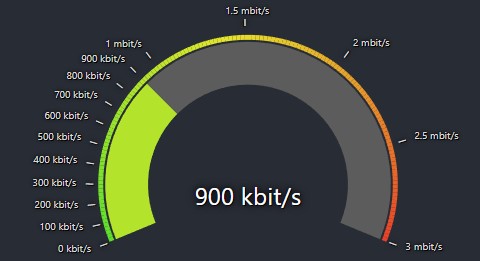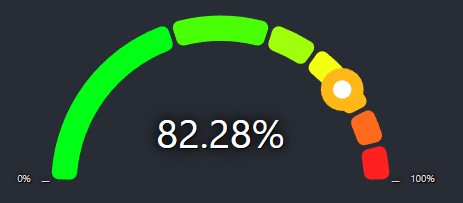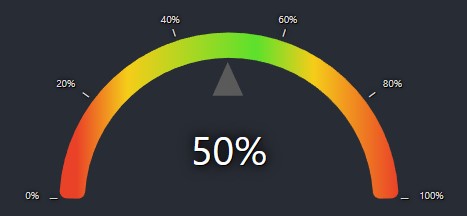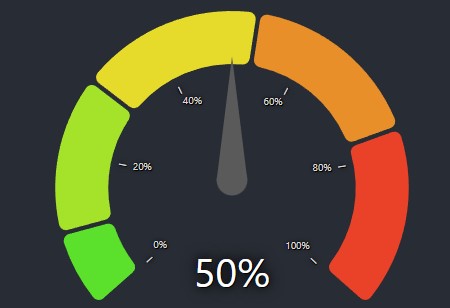react-gauge-component
React Gauge Chart Component for data visualization.
This is forked from @Martin36/react-gauge-chart 0b24a45. Key differences:
- Added min/max values
- Added grafana based gauge
- Added arcs limits in value instead of percent
- Added inner/outer ticks to the gauge for reference of the values
- Added blob pointer type
- Added arrow pointer type
- Added tooltips on hover for the arcs
- Added arc with linear gradient colors
- Full responsive
- All render flow fixed and optimized avoiding unecessary resource usage. Performance test, left is original: https://user-images.githubusercontent.com/45375617/239447916-217630e7-8e34-4a3e-a59f-7301471b9855.png
- Refactored project structure to separated files
- Refactored to Typescript
- Added complex objects for better modulation and organization of the project
- Fixed Rerenderings making arcs to be repeated in different sizes
- Fixed needing to set height bug
- Fixed needing to set id bug
Demo
https://antoniolago.github.io/react-gauge-component/
Usage
Install it by running npm install react-gauge-component --save or yarn add react-gauge-component. Then to use it:
import GaugeComponent from 'react-gauge-component';
//or
import { GaugeComponent } from 'react-gauge-component';
//Component with default values
<GaugeComponent />For next.js you'll have to do dynamic import:
import dynamic from "next/dynamic";
const GaugeComponent = dynamic(() => import('react-gauge-component'), { ssr: false });
//Component with default values
<GaugeComponent />Examples
Simple Gauge.

Show Simple Gauge code
### Simple Gauge ```jsxCustom Bandwidth Gauge.

Show Bandwidth Gauge code
### Bandwidth Gauge ```jsx const kbitsToMbits = (value) => { if (value >= 1000) { value = value / 1000; if (Number.isInteger(value)) { return value.toFixed(0) + ' mbit/s'; } else { return value.toFixed(1) + ' mbit/s'; } } else { return value.toFixed(0) + ' kbit/s'; } }Custom Temperature Gauge

Show Temperature Gauge code
### Temperature Gauge ```jsxGauge with blob.

Show Gauge with blob code
### Custom gauge with blob ```jsxGradient with arrow gauge.

Show Gradient with arrow code
### Custom gradient with arrow ```jsxCustom radial gauge.

Show Custom Radial Gauge code
### Custom Radial Gauge ```jsxAPI
Props:
type: string: The type of the gauge, values can be"grafana","semicircleand"radial". Default:"grafana".id: string: A unique identifier for the div surrounding the chart. Default:"".className: string: Adds aclassNameto the div container. Default:"gauge-component-class".style: React.CSSProperties: Adds a style object to the div container. Default:{width: 100}.marginInPercent: number | {left: number, right: number, top: number, bottom: number}: Sets the margin for the chart inside the containing SVG element. Default: "grafana":{ top: 0.12, bottom: 0.00, left: 0.07, right: 0.07 }. "semicircle":{ top: 0.08, bottom: 0.00, left: 0.07, right: 0.07 }"radial":{ top: 0.07, bottom: 0.00, left: 0.07, right: 0.07 }value: number: The value of the gauge. Default:33.minValue: number: The minimum value of the gauge. Default:0.maxValue: number: The maximum value of the gauge. Default:100.arc: object: The arc of the gauge.cornerRadius: number: The corner radius of the arc. Default:7.padding: number: The padding between subArcs, in rad. Default:0.05.width: number: The width of the arc given in percent of the radius. Default: "grafana":0.25. "semicircle":0.15"radial":0.2.nbSubArcs: number: The number of subArcs. This overridessubArcs. Default:undefinedcolorArray: Array<string>: The colors of the arcs. This overridessubArcscolors. Default:undefinedemptyColor: string: The default color of the grafana's "empty" subArc color. Default:"#5C5C5C"gradient: boolean: This will draw a single arc with all colors provided in subArcs, using limits as references to draw the linear-gradient result. (limits may not be accurate in this mode) Default:false.subArcs: Array<object>: The subArcs of the gauge.limit: number: The subArc length using value as reference. When no limits or lengths are defined will auto-calculate remaining arcs limits. Example of valid input:subArcs: [{limit: 50}, {limit: 100}]this will render 2 arcs 50/50length: number: The subArc length in percent of the arc (as the behavior of the original project). Example of a valid input:subArcs: [{length: 0.50}, {length: 0.50}], this will render 2 arcs 50/50color: string: The subArc color. When not provided, it will use default subArc's colors and interpolate first and last colors when subArcs number is greater thancolorArray.showTick: boolean: Whether or not to show the tick. Default:false.tooltip: object: Tooltip object.text: stringtext that will be displayed in the tooltip when hovering the subArc.style: React.CSSProperties: Overrides tooltip styles.
onClick: (event: any) => void: onClick callback. Default:undefined.onMouseMove: (event: any) => void: onMouseMove callback. Default:undefined.onMouseLeave: (event: any) => void: onMouseLeave callback. Default:undefined.
[ { limit: 33, color: "#5BE12C"}, { limit: 66, color: "#F5CD19"}, { color: "#EA4228"}, ]
pointer: object: The value pointer of the gauge. Grafana gauge have it's own pointer logic, but animation properties will be applied.type: stringThis can be "needle", "blob" or "arrow". Default:"needle"hide: booleanEnabling this flag will hide the pointer. Default:falsecolor: string: The color of the pointer. Default:#464A4FbaseColor: string: The color of the base of the pointer. Default:#464A4Flength: number: The length of the pointer 0-1, 1 being the outer radius length. Default:0.70animate: boolean: Whether or not to animate the pointer. Default:trueelastic: boolean: Whether or not to use elastic pointer. Default:falseanimationDuration: number: The duration of the pointer animation. Default:3000animationDelay: number: The delay of the pointer animation. Default:100width: number: The width of the pointer. Default:20
labels: object: The labels of the gauge.valueLabel: object: The center value label of the gauge.matchColorWithArc: boolean: when enabled valueLabel color will match current arc colorformatTextValue: (value: any) => string: The format of the value label. Default:undefined.style: React.CSSProperties: Overrides valueLabel styles. Default:{fontSize: "35px", fill: "#fff", textShadow: "black 1px 1px 0px, black 0px 0px 2.5em, black 0px 0px 0.2em"}maxDecimalDigits: number: this is the number of decimal digits the value will round up to. Default:2hide: boolean: Whether or not to hide the value label. Default:false.
tickLabels: objectThe tickLabels of the gauge.type: string: This makes the ticks"inner"or"outer"the radius. Default:"outer"hideMinMax: boolean: Whether or not to hide the min and max labels. Default:falseticks: Array<object>: The ticks of the gauge. When not provided, it will use default gauge ticks with five values.value: number: The value of the tick.valueConfig: object: The config of the tick's value label. When not provided, it will use default config.lineConfig: object: The config of the tick's line. When not provided, it will use default config.
defaultTickValueConfig: object: The default config of the tick's value label.formatTextValue: (value: any) => string: The format of the tick's value label. Default:undefinedstyle: React.CSSProperties: Overrides tick's valueConfig styles. Default:{fontSize: "10px", fill: "#464A4F", textShadow: "black 1px 1px 0px, black 0px 0px 2.5em, black 0px 0px 0.2em"}maxDecimalDigits: number: this is the number of decimal digits the value will round up to. Default:2hide: boolean: Whether or not to hide the tick's value label. Default:false
defaultTickLineConfig: object: The default config of the tick's line.width: number: The width of the tick's line. Default:1length: number: The length of the tick's line. Default:7color: string: The color of the tick's line. Default:rgb(173 172 171)distanceFromArc: number: The distance of the tick's line from the arc. Default:3hide: boolean: Whether or not to hide the tick's line. Default:false